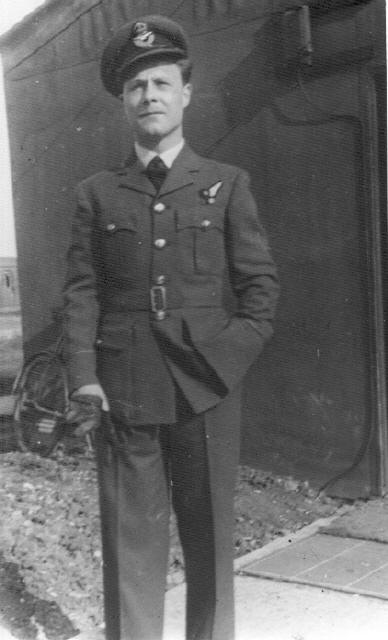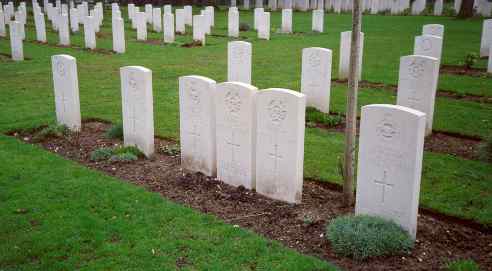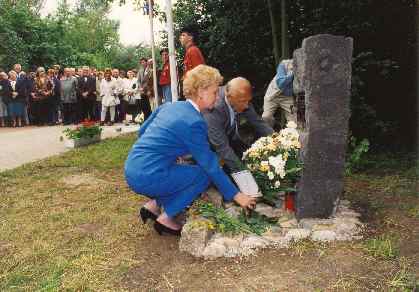more: www.tiemens.info
TRAGEDY IN THE ELDENSCHE POLDER
As regular readers of 'Air Link' wil! know, Dr. Tiemens has given me invaluable help in unravelling some of the finer points of the German Air Defence system. Unfortunately, much of the written material which he has sent me was in his native Dutch, and has been difficult for me to understand. Attempts to find a translator were unsuccessful until an enquiry at Lincoln University put me in touch with Vicky Scorthorne, an English lady who has spent a significant amount of time in Holland. Vicky has been kind enough to translate some of Dr. Tiemens' material for me, and what follows is an edited version of fhe story of a Lancaster which crashed on fhe oufskirts of Arnhem in 1944. (Editor)

The crew of Lancaster VR - V, left to right: Donald Morissen, Arnold Hupman, Gerald Quinn, Harold Fletcher, Clifford Johnston, Philip McManus and Edward Fahy
At about 1.30 on the night of the 16/17th. June 1944, a Lancaster crashed in flames some 100 metres south of the Middelweg (now Elderhofseweg) on the outskirts of Arnhem. All seven crew members lost their lives. This article sets the circumstances of the crash against the background of the air war. A quick glimpse of the map of Europe is enough to show that the Netherlands were of great importance in the Luftwaffe's fight against Allied air power. British and later American bombers flew over the country to reach their bombing targets in Germany, and the Luftwaffe commanders considered the area as a welcome "buffer zone" for the Reichsluftverteidigung (German air defences). With this in mind, the Germans attempted, with the aid of the late st technology and new tactics, to build a strong defence organisation to combat the gathering Allied air offensive. Important parts of the organisation were situated within the province of Gelder - Deelen airfield for example, the largest night fighter base in the country. Aircraft movements in the airs pace over the province we re monitored by the radar stations Hase (Hare) near Harderwijk, Eisbär (Polar Bear) near Sondel, and Salzhering (Salt Herring) south of the Helder. In January 1942 the staff of the 1. Nachtjagdivision were moved into premises at Schaarsbergen, from where German night fighters, and later day fighters we re controlled. The air space which the division defended was the most important of the whole German system, covering, as well as the Netherlands, the northern half of Belgium and a large part of Western Germany. The 1st. Night Fighter Division later became the 3rd. Fighter Division, and was housed in the massive bunker 'Diogenes' which had been built alongside the Koningsweg in Schaarsbergen. Diogenes was at the heart of a fine web which the Germans had spun across this part of Europe. The entry of Allied aircraft into the division's air-space rarely went unnoticed. It nearly always caused a vibration in the web and the vibration was transmitted to Schaarsbergen where Oberst Walter Grabmann and bis staff worked feverishly to find a suitable response. This was dependent on a number of factors, such as the nature and size of the penetration, the type of aircraft being used, the route being followed and the likely target. The weather conditions at the time were also important. Naturally, the Senior Officers of Bomber Command tried, in every possible way, to mislead the Germans for as long as possible - to keep them in the dark about the true nature of their targets. Sometimes they were successful, but on other occasions, as during an attack on Nuremburg on the 31st. March 1944, the Germans reaped an important harvest amongst the attacking aircraft. Air Marshal Sir Arthur Harris gave the order for two large operations during the night of 16/17th. June 1944. The first, with 405 aircraft, was a major attack on V1 launch sites in the Nord - Pas de Calais area of France. The second, with 162 Halifaxes, 147 Lancasters and 12 Mosquitos, was targeted on the synthetic fuel installations at Sterkrade near Oberhausen. The German defences thus had two major raids to deal with, the first affecting the 4th. Fighter Division, controlled from Metz in France, and the second affecting the 3rd. Fighter Division, controlled from Schaarsbergen. Amongst the 321 aircraft making their way to Sterkrade were 16 Lancasters of 419 (‘Moose’) Squadron of the RCAF, one ofwhich, KB728, had on board the Squadron's most experienced crew - all coming to the end of their first tour of operations. Of the seven men, the pilot, navigator, bomb-aimer and rear gunner were Canadian - the engineer, radio-operator and mid-upper gunner were British.


Pilot Officer Harold Fletcher and Flying Officer Arnold Hupman photografed on the same day and the same place
VR-V, a Lancaster X, took off from Middleton St. George at 23.08, loaded with one cookie, 12x 500 lb. GP bombs and a little less than 2,000 gallons of fuel. There was very heavy cloud cover and it was some time before the Lancaster broke out of cloud at 14,000' in the light of a half-moon. Oberst Walter Grabmann and bis staff in Diogenes had early warning of the approach of the Sterkrade bomber fleet since crews were using their H2S radars to confirm their positions - and the radar emissions were being tracked by the German monitoring service. Grabmann was convinced that the formation was on its way to the Ruhr and first contacts gained by the long-range radars on the coast confirmed bis suspicions. He warned his night-fighter crews at Deelen, Venlo, Leeuwarden and St. Truiden in Belgium to stand by. At 23.19 the first Heinkei He 219 of l/NJG 1 took off from Venlo airfield, followed four minutes later by a second which, not long afterwards, shot down the first victim of the Sterkrade attacking fleet.

A state of the art He 219 nightfighter of I/NJG 1
The He 219 was a very modern night fighter, fitted with the powerful Lichtenstein SN2 radar, which the British had not, until then, been able to jam. In all, 14 fighters from Venlo took part in the battle, destroying nine allied aircraft, of which seven had not reached the target. Some time after the aircraft from Venlo took off, a further fifteen night fighters (mainly Me 110s) took off from nearby Deelen. In the following hours they claimed seven victims. In addition to this information, which comes from official German sources, the diary entries of Feldwebel Handke, Hauptman Martin Drewes' wireless operator, tell us that Me110s of III/NJG 1 from Leeuwarden also took part in the battle. Drewes himself shot down two returning Lancasters over the North Sea. By Bomber Command records, 21 aircraft were lost to fighter attack, and a further 10 to FLAK (AA guns) - 22 out of the 31 being Halifaxes. German claims amounted to rather more than that, but not all of these could be confirmed, particularly those not producing wreckage on the ground. One of the reasons cited for the loss by Martin Middlebrook was that the bomber stream passed close to the radio and light beacon at Bocholt around which the German controller had directed his fighters to orbit. They were thus able to join the stream with a minimum of delay.The ORB at Middleton St. George reported that "the whole route from just before crossing the Dutch coast to the target and back out to sea was stiff with night fighters, and dotted with aircraft falling in flames." 419 Squadron crews reported fierce German defence, at least five of the sixteen having at least one episode with night-fighters. As time passed without a message to say that VR-V had landed elsewhere, the-aircraft was recorded as "missing" - "Nothing further was heard from this aircraft after take-off and its failure to return to base is presumed to be due to enemy action." On the ground in Elden, Mr. Beijer who had heard aircraft passing overhead, went outside his house to see what was happening. He saw a low-flying aircraft in flames. It suddenly changed direction and almost immediately afterwards crashed into the ground. The following day, one of the aircraft's wings was found about a kilometre away from the point of impact. Mr. Tijssen was also a witness. He saw the burning Lancaster coming nearer and feared for a moment that it would crash on his farm. It missed by about 500 metres and crashed in a sea of flames.

The wreckage of Lancaster VR-V in the Eldensche Polder, some kilometers south of Arnhem
The wreckage lay burning for many hours, with continuous explosions of ammunition which made it impossible to get close. Once the fire had died down, Mr. Schouten, another farmer, went to have a look. "I saw three bodies in the aircraft and when I looked in the field, I found another three, one of which lay in a ditch under a parachute. In daylight on the following morning I found another parachute which was completely open. There was no one near it so I assumed that the person who used it had landed weIl and escaped from the Germans." The Germans did not want the bodies recovered immediately so that they remained at the crash site for several days. The bodies were finally removed in four coffins on Tuesday 20th. June. One coffin contained the remains of three crew members, although three grave numbers we re reserved for it. Normally, the removal and burial of bodies was quickly and efficiently carried out by the Germans and it may be that in this case the delay lay in the village of Elden, where, to the displeasure of many parishioners, Pastor Schimmel refused to give permission for the dead airmen to be buried in 'his' churchyard. He had taken his decision on the grounds that only those people who had been christened as Roman Catholics could be buried in ground which had been consecrated as a burial place for Roman Catholics. It was eventually decided that the airmen were to be buried in the cemetery of the Netherlands Reformed Church in Huissensedijk. Not long afterwards, Pastor Schimmel's replacement, Father Van Vugt also refused to bury a body, this time of a German who according to his papers was an 'Evangelist'. In the end the German was also buried at the Reformed Church. Not too much notice was taken of this incident, because it involved a German, and because the battle of Arnhem had started and people had other things to think about. A local joiner called Alberts made an aok cross for each of the airmens' graves and the people of Elden collected money for the upkeep of each grave, and placed flowers on them.


Left: shortly after the war two local girls lay flowers on the graves of two crew members at Canadian War Cemetery, Groesbeek. Right: six graves together; Gerald Quinn's grave got another location - not known is why
German conclusion that they were dealing with the remains of 6 bodies seems to have flowed from deductions rather than facts. It was known that a Lancaster's crew consisted of 7 members. Two of the bodies were identified immediately and a third from the number on bis parachute, so that the remains removed from the wreckage must have been from three unidentified bodies. The apparently used parachute found near the crash site gave rise to the possibility that one crew member managed to escape. After the war the bodies were exhumed and re-buried in the Canadian war cemetery in Groesbeek. Examination of the coffins showed that the remains of only five bodies were present, and since no trace has ever been found of survivors of the crash, it is assumed, realistically, that the two missing bodies were completely consumed in the post-crash fire. Nothing remains at the crash site to remind people of what happened there in June 1944. Where once there were fields bounded by dykes, there are now the residential districts of Elderveld and Elderhof, built in the 1970s. The small parcel of land where the Lancaster landed is now taken up by a large playing field and park where, at the initiative of the 'Historische Kring Elden' a memorial was erected exactly 50 years later, to the memory of its crew.
 Harold Fletcher's sister Vera and brother Joseph lay flowers near the monument on the place where the Lancaster crashed 50 years before. The monument was unveiled by the burgomaster of Arnhem to which the area belongs now and the burgomaster of Elst, which is the municipality Elden belonged to in 1944
Harold Fletcher's sister Vera and brother Joseph lay flowers near the monument on the place where the Lancaster crashed 50 years before. The monument was unveiled by the burgomaster of Arnhem to which the area belongs now and the burgomaster of Elst, which is the municipality Elden belonged to in 1944
I am most graleful to Dr. Tiemens lor making this material available to us, and to Vicky Scorthorne lor translating it. War-time aircrew of Bomber Command have a warm regard for the people of Holland, many of whom look the most serious risks to aid survivors from aircraft lost over their country. The Dutch people also suffered death and destruction from the air war which look place over their heads, but with very rare exceptions accepted that these losses were inevitable if their country was to be freed from German occupation. Lincolnshire losses on this operation included two Lancasters from 101 Squadron - Ludford Magna, one from 103 Squadron - Elsham Wold, three from 550 Squadron - North Killingholme and two from 576 Squadron - Elsham Wold. The main losses, including that of KB 728, were sustained by Squadrons of 4 and 6 Groups. (Editor)
Click here to go back to the Home Page